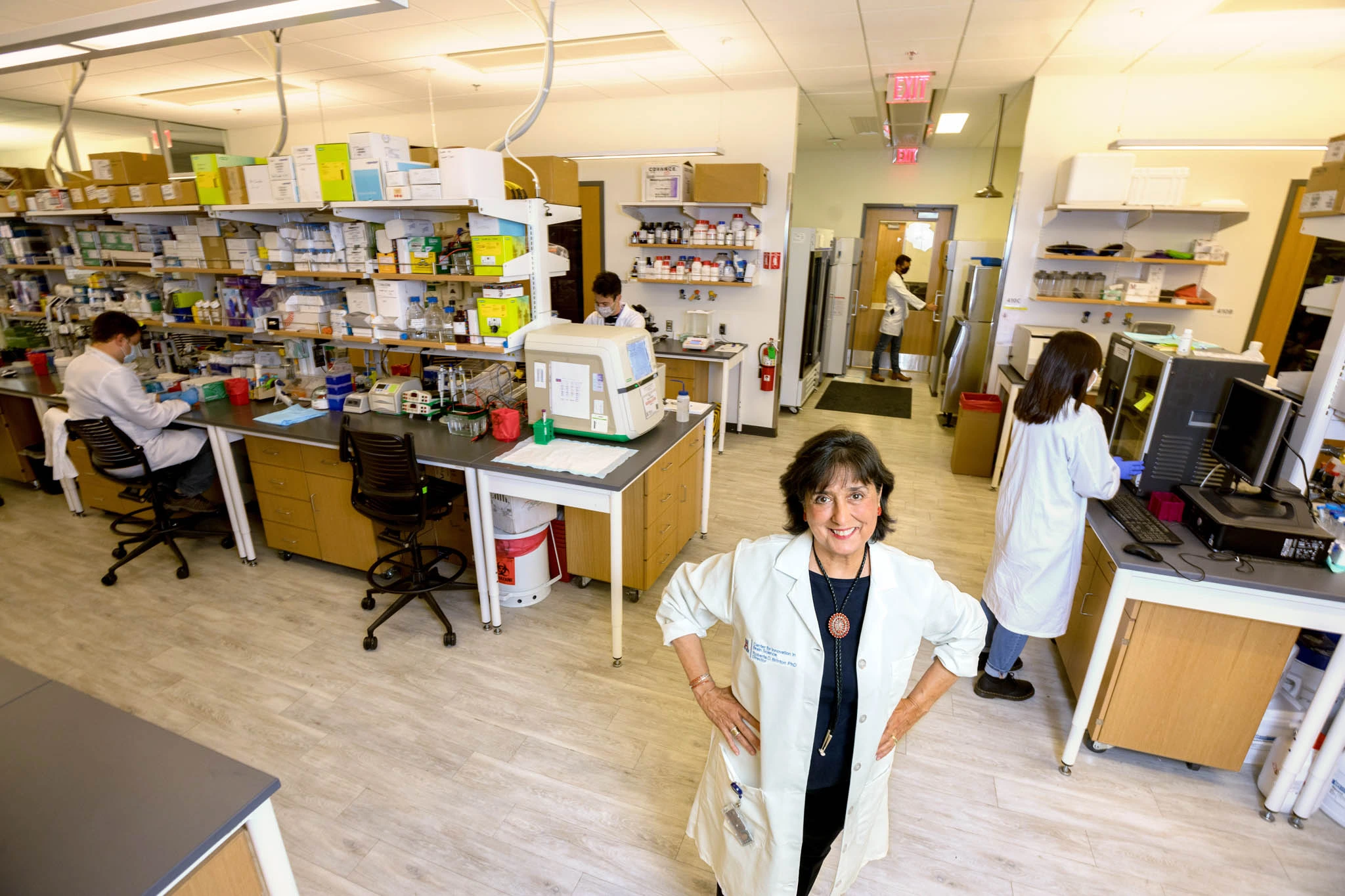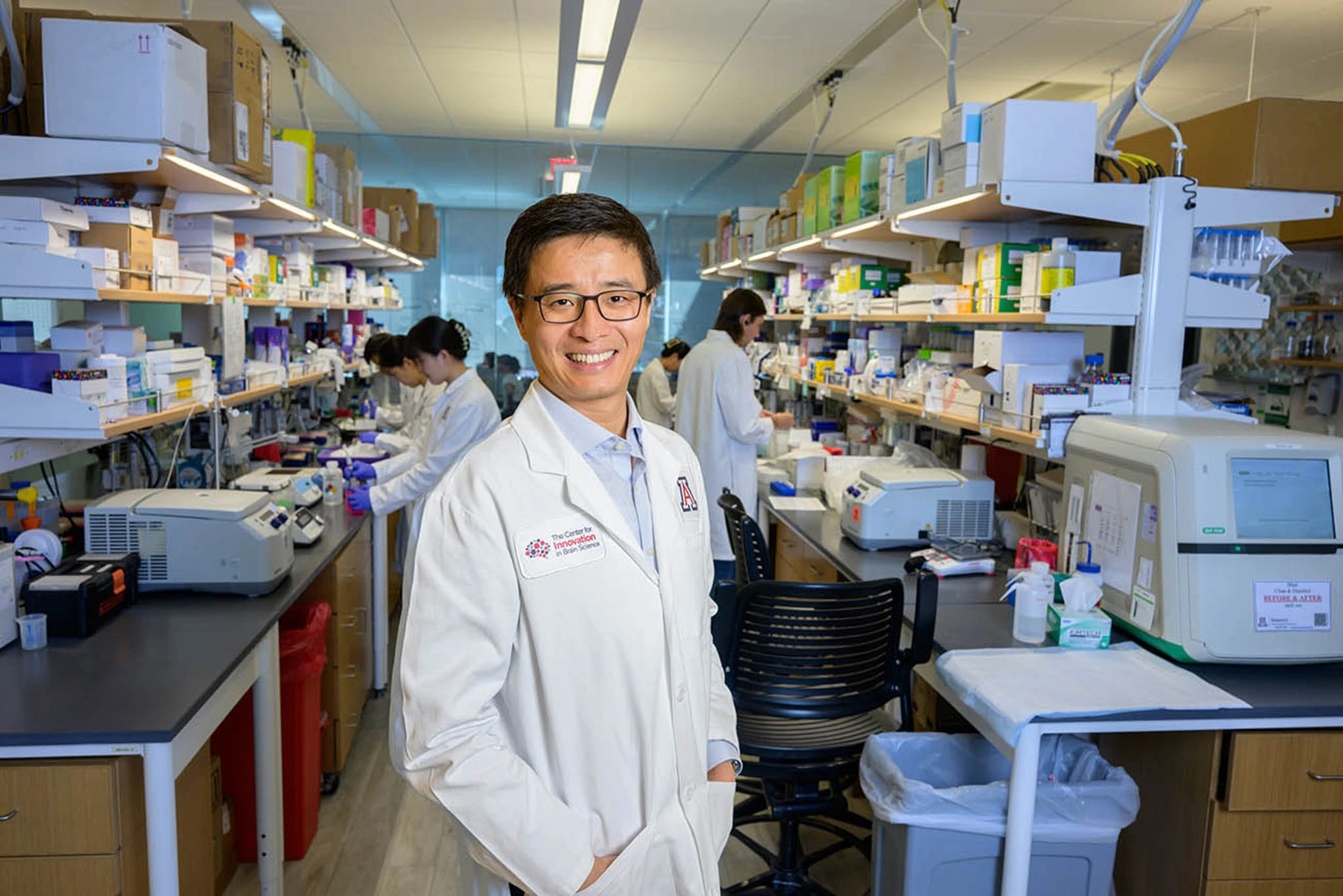Big Brain
How researchers at the U of A’s Center for Innovation in Brain Science are working toward a better understanding of Alzheimer’s

Roberta Diaz Brinton
Chris Richards
Neuroscientist Roberta Diaz Brinton ’79 ’81 ’84 believes regenerating the brain can mean regenerating a life. An expert in Alzheimer’s disease and director of the University of Arizona Health Sciences Center for Innovation in Brain Science (CIBS), Brinton has built a career on bringing hope to an area of medicine where, historically, there has been very little.
“The grand challenge we are addressing is that in the 21st century, there is not a single cure for neurodegenerative diseases,” she says, a category that includes multiple sclerosis, Parkinson’s disease and amyotrophic lateral sclerosis, or ALS. “Our mission is to create innovations in brain science of the future for those who need a cure today. And our vision is vibrant brains that last a lifetime.”
Brinton’s area of expertise includes the aging female brain and regenerative therapeutics. One of her early innovations came in the 1990s when she was investigating the interaction between allopregnanolone, a natural neurosteroid in the brain, and nerve cells. One morning, she looked through a microscope at a culture of nerve cells, and noticed that there were more than the night before. She had just discovered that allopregnanolone promotes the regeneration of nerve cells within the brain.
This transformative discovery was the start of decades of research that led to ongoing clinical trials of allopregnanolone for Alzheimer’s and Parkinson’s diseases, a Presidential Citizens Medal from President Barack Obama and induction into the National Academy of Inventors.
Brinton led a 2021 CIBS study that focused on the effects of hormone therapy medications commonly used in treating the side effects of menopause — estrogens, progestins and combination therapies approved by the U.S. Food and Drug Administration — on neurodegenerative diseases.
During the study, Brinton and the research team examined the insurance claims of nearly 400,000 women aged 45 and older who were in menopause. The results, which were published in Alzheimer’s & Dementia: Translational Research & Clinical Interventions, found that women who underwent menopausal hormone therapy for six years or more were 79% less likely to develop Alzheimer’s and 77% less likely to develop any neurodegenerative disease.
They also found that the use of the natural steroids estradiol or progesterone resulted in greater risk reduction than the use of synthetic hormones, that oral hormone therapies resulted in a reduced risk for combined neurodegenerative diseases, and that hormone therapies administered through the skin reduced the risk of developing dementia. Overall risk was reduced the most in patients 65 years or older.
Additionally, therapy lasting longer than one year had a greater protective effect on Alzheimer’s, Parkinson’s and dementia than therapy of less than one year.
“With this study, we are gaining mechanistic knowledge,” Brinton says. “This reduction in risk for Alzheimer’s disease, Parkinson’s and dementia means these diseases share a common driver regulated by estrogen, and if there are common drivers, there can be common therapies.”
Brinton also co-authored a paper led by researchers at Weill Cornell Medicine and published in Scientific Reports demonstrating that the menopausal transition stage has pronounced effects on the brain’s structure, connectivity and energy metabolism, and provides a neurological framework for both vulnerability and resilience.
Discovering Alzheimer’s drivers
Coco Tirambulo’s parents immigrated to the United States from the Philippines and operated assisted living care homes in Tucson. There, Tirambulo came to understand firsthand the effects of dementia, Alzheimer’s and other age-related conditions.
“It was a very nurturing environment, like having many grandparents, aunts and uncles around,” says Tirambulo, now a third-year medical and doctoral student who works with Brinton. “Growing up, I had no idea that a lot of them had chronic illnesses. But as I grew older, that’s what led me to go into the health sciences, because, as a Filipino American, we have the mindset that we care for elders as they grow older.”
Before medical school was even on her radar, Tirambulo earned two U of A master’s degrees: one in epidemiology from the Mel and Enid Zuckerman College of Public Health and another in molecular and cellular biology as part of the Pre-Medical Admissions Pathway, or P-MAP, at the College of Medicine – Tucson. At the same time, she worked as a research specialist at the Arizona Center on Aging.
Tirambulo’s work is focused on studying apolipoprotein E, or APOE, a gene that has been linked to Alzheimer’s. APOE makes a protein that carries cholesterol and fats through the bloodstream. Different versions of APOE are more or less effective at moving fats. One version, APOE4, is associated with an increased risk of developing Alzheimer’s and earlier onset of the disease, though some people with APOE4 never develop any form of dementia.
“Is the APOE4 protein a driver of the Alzheimer’s disease pathology? It may not be an absolute, but it’s definitely a risk factor,” Brinton says. “If someone develops Type 2 diabetes and also is an APOE4 carrier, now you’ve got two risk factors instead of one. That makes APOE4 important for us to investigate as a potential target for intervention."
Tirambulo is on track to complete her MD/Ph.D. in 2028. She envisions a future where there are treatments and even a cure for the disease that affects so many.
“Through her experiences growing up, Coco understands that when one person in the family has Alzheimer’s, the whole family has Alzheimer’s. That perspective inspires all of us,” Brinton says.
Making data work
Part of the challenge of studying APOE is synthesizing the enormous amount of data available on the subject and discerning how that data might be used in moving toward a therapy or treatment.
Tirambulo uses data from the Wisconsin Alzheimer’s Disease Research Center, whose large and diverse dataset of people who carry the APOE gene provides ample data for research discovery. Identifying commonalities provides Tirambulo with subsets of at-risk patient profiles she can explore for potential drug development.
“When I find commonalities in the data, I want to know what makes a person able to respond to a certain drug versus not respond. From there, I’m applying it to other people that have similar profiles,” Tirambulo says. “The goal is that if this works for this person, this can work for you.”
Ultimately, she hopes to find evidence that APOE4 could be a novel therapeutic target to help lower a person’s risk of Alzheimer’s development. From there, Brinton believes there could be a way to target APOE4 specifically or perhaps develop a drug that molecularly transforms APOE4 into APOE3, one of the gene variants that has a neutral effect on Alzheimer’s development.
“Imagine if you could begin this precision medicine early intervention to change the trajectory of a person from being a high risk to a low risk, and it could be done through therapeutic interventions in midlife, long before their disease develops,” Brinton says.

Fei Yin
Kris Hanning
Mighty mitochondria
Fei Yin says most of the kids in his elementary-school class in China wanted to be scientists, but few knew what that meant — or what it took.
After completing his undergraduate studies in biochemistry, Yin matriculated at the University of Southern California, where his path became clearer. His doctoral adviser, Enrique Cadenas, was an expert in mitochondria, the “powerhouses” of the cell that generate the energy it needs to do its job. As a postdoctoral researcher, Yin worked with Brinton before she returned to her Wildcat roots and recruited him to join her at CIBS and as an associate professor of pharmacology in the College of Medicine – Tucson.
He has since devoted his career to unraveling the mysteries of mitochondria, including making discoveries about how faulty mitochondria might lead to brain diseases such as Alzheimer’s. In lay terms, he discovered that the brain’s self-cleaning machinery may be central to Alzheimer’s: Specialized cells take out the trash in the brain; when they break down, waste builds up, possibly setting the stage for Alzheimer’s disease.
Most mitochondria research in the context of Alzheimer’s focuses on neurons, brain cells that consume a lot of energy to keep us perceiving, thinking and forming memories. But the Yin Lab shifted its focus to astrocytes, star-shaped cells that support neurons and remove waste products from the brain — waste products including lipids, fatty compounds that are essential to brain function.
Scientists have been studying lipids since 1906, when Alois Alzheimer noted abnormal lipid structures in autopsied brains. But the bulk of Alzheimer’s research focused on other phenomena, such as the buildup of abnormal protein structures including plaques and tangles in Alzheimer’s brains. Drugs targeting these proteins have yet to result in a cure, though, leading to an expanded search for Alzheimer’s root causes. Some scientists, like Yin, focus on lipids.
“About half the brain’s dry weight is lipids, but they have turnover,” he says. “Our studies suggest that mitochondria in astrocytes get rid of lipid waste in the brain.”
When an astrocyte’s mitochondria are impaired, they are unable to break down lipid waste. The Yin Lab discovered that when astrocytes are unable to efficiently process this waste, lipids accumulate in the brain like garbage piling up on the sidewalk, harming their neighboring cells and the brain environment.
Yin is now testing the hypothesis that lipid accumulation initiates or accelerates the progression of Alzheimer’s disease.
“Lipid balance is important to maintain for brain function. If the balance is disrupted, there will be consequences,” he said. “We believe that altered lipid turnover significantly contributes to neurodegenerative diseases, just as it does to metabolic and cardiovascular diseases.”
Moving toward drug discovery
Human DNA might also hold clues to why some mitochondria go awry. The APOE4 gene, also studied by Coco Tirambulo, is the greatest genetic risk factor for Alzheimer’s, which was previously shown to be associated with plaques and tangles. When Yin looked at the gene through his lipid-focused lens, he was intrigued to find that it was also implicated in mitochondrial dysfunction and lipid imbalance in astrocytes.
“We found that, compared to the normal form, APOE4 has a reduced ability to transport lipids to mitochondria in astrocytes for degradation,” Yin says. “Now we’re trying to determine how this disrupted lipid metabolism in early stages is connected to key hallmarks of the disease: plaques, tangles, neuronal loss and cognitive impairment.”
Yin says his discoveries about lipid dysregulation as a central mechanism driving Alzheimer’s disease — and APOE4’s role in this dysfunction — are a highlight of his career so far, and he hopes they will be a meaningful contribution toward developing treatments not only for Alzheimer’s but also for other neurodegenerative diseases.
“Disrupted lipid metabolism is not unique to Alzheimer’s disease. There is accumulating evidence demonstrating lipid dysregulation in Parkinson’s disease, in ALS, in Huntington’s disease — nearly all neurodegenerative diseases,” he says. “It could be a common mechanism underlying these devastating diseases.”
